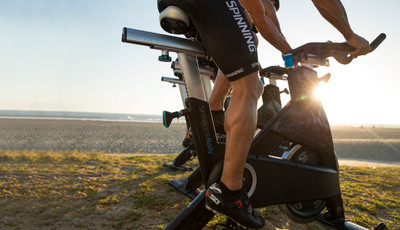
How to Avoid Tailbone Tenderness
Posted by Spinning® on Apr 18th 2018
UPDATED: November 3, 2021
By Cori Parks
Have you ever experienced a dull ache on your tailbone and wondered if it had anything to do with the hours you log on your bike? Well, when it comes to an achy tailbone, riding a bike can actually get a “bum rap.” In fact, it’s possible for you to experience this type of pain and it has nothing to do with your riding at all – no matter how many miles you log. Perhaps you sit a lot at the office or in your car. More on that in a moment…
For now, keep in mind that an achy tailbone is distinct from the common issue of “beginner’s sore bum” that occurs until your body acclimates to riding a bike. As you become a stronger rider, you will be able to ride with more resistance, which not only leads to increased fitness, it keeps you lighter in the saddle as you pedal against that resistance. But what we’re talking about here is different—it's pain or tenderness right on the tailbone and surrounding area that might feel like a bruise that never heals. Read on for more information about possible causes as well as how you can safeguard your tailbone with proper bike setup.
Natural Tailbone Curvature
Our spines have several natural curves to help stack the spine supportively. (You can visualize it, the little curve out below the neck, the little curve in at the lower back.) Some people have more pronounced curvatures while others have less. For most people, their tailbone curves slightly inward…but your signature spinal curvature is unique, and it may dictate the amount of pressure your tailbone sustains while sitting.
Awareness is key and strength is crucial. While you do have a unique set of curves to your spine, everyone benefits from muscular scaffolding of the spine. Pairing your regular Spin® training with head-to-tail strengthening exercises will ensure you keep great spinal integrity.
Riding with “The Times”
There’s another factor that contributes to our tailbones bearing weight. You’re probably aware that humans now sit much more than we're designed to. But did you know that the result is that our “tail bones" have actually begun to “tuck” under our bodies to compensate?! Yikes. And still, as we get heavier and our bellies pooch with age, this puts additional strain on the lower back.
Counteracting the detrimental effects of a sedentary lifestyle is important and leads to the positive upward spiral of fitness leading to more fitness; riders can ride more, so they do ride more. The gains in fitness lead to healthier weight management, decreased stress on the spine and increased postural strength.
Get it Checked Out
If a sedentary lifestyle – or anything else for that matter – is causing your tailbone to ache, it might indicate bruising or soft tissue injury to the area around the coxyx (tailbone), or there could actually be a bone fracture. So, the very first thing you’ll want to do is visit your doctor to see if an X-ray is warranted.
Spin® Saddle Design + Proper Bike Fit
While your attention to your dynamic, ever changing body is important, you're only half of the bike-body partnership that is Spinning®.The Spin® bike saddle allows for the tailbone to be free from pressure, so sitting on a Spin® bike is not necessarily a contributing factor to your achy tailbone.
Remember too that the actual points of contact on the bike are at the base of the hip bones (sitz bones/ischial tuberosity) as well as the hands and feet. The tailbone shouldn’t be taking any pressure if you’re in proper alignment. You can check out more training tips for bike safety and setup here. In simple terms, your tailbone should actually drape over the back of the saddle while maintaining postural integrity in the lower back.
If your tailbone is in contact with the saddle, be sure to wear padded cycling bottoms and/or use a gel seat cover for cushion. Also, you may be able to adjust your bike setup to relieve the tailbone pressure. One common solution is to lower the handlebars, which will result in more of a forward (anterior) pelvic tilt. However, be sure that this pelvic tilt doesn’t cause pressure in other sensitive areas. Also be sure that the lowered handlebars doesn’t cause strain in your neck and/or back.
Hopefully now you’re clear on the distinctions between “beginner’s sore bum” and an actual achy tailbone. You also now know the ways to protect your rear side, so that you can keep your eyes on the bright side – all of those gains that you make on your Spin® bike!
